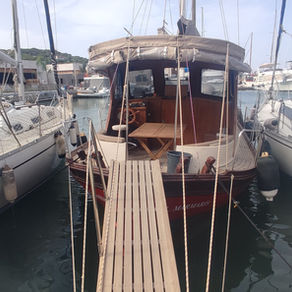Critical Considerations in Teak Deck Manufacturing
- marmaristms

- Apr 23
- 2 min read
Teak wood is one of the most valued and durable materials used in marine decking due to its longevity and high resistance to water and environmental factors. It is widely preferred in yachts and boats. However, achieving a successful and lasting teak deck installation requires strict adherence to the following technical criteria.
1. Material Quality and Preparation
Wood Selection: The teak wood used must comply with marine standards, featuring high density, uniform grain structure, and minimal knots or cracks.
Moisture Content: The wood’s moisture content should be maintained between 14-16%, not exceeding 20%. This minimizes the risk of deformation, cracking, and shrinkage after installation.
Protection and Treatment: The wood should be treated against fungi, mold, and harmful organisms. Proper sanding and surface preparation must be applied to ensure smoothness.
2. Installation Conditions and Surface Preparation

Environmental Conditions: Installation should ideally occur at temperatures above 15°C and under dry weather conditions. Avoid installation during humid or rainy weather to ensure optimal performance of adhesives and sealants.
Surface Preparation: Both the sub-deck surface and teak planks must be thoroughly cleaned of dust, oil, and contaminants to enhance adhesion. Precision sanding ensures a smooth and uniform surface.
3. Cutting and Joining Techniques
Plank Dimensions: Teak planks are typically cut to thicknesses of 8-15 mm and widths of 40-60 mm. They must be precisely shaped to fit the contours and slopes of the vessel.
Joining Methods: To ensure waterproofing and durability, planks should be joined using offset (staggered), mitered, or dovetail joints. No gaps or cracks should be present at seams.
Fasteners: Screws, bolts, and fasteners must be made of stainless steel or marine-grade materials. Over-tightening and deformation during installation should be avoided.
4. Waterproofing and Durability
Sealants and Adhesives: Sealants and adhesives used must be marine-grade, flexible, and long-lasting. They should provide waterproofing while maintaining elasticity.
Detail Installation: Installation of bulwarks, cap rails, and other deck fittings requires special attention to waterproofing and durability. All joints must be professionally sealed.
5. Aesthetics and Workmanship Quality

Surface Uniformity: The teak deck must be flawless both functionally and visually. The natural texture and color of the wood should be preserved, and the surface should be smooth and consistent.
Precision Craftsmanship: Cutting, fitting, and finishing must be executed with high precision. The quality of workmanship directly impacts the vessel’s prestige and the deck’s lifespan.
6. Standards and Regulations
Marine Standards Compliance: Teak deck manufacturing must comply with Turkish Lloyd and international marine standards. Material selection, installation techniques, and safety criteria should adhere to these standards.
Environmental and Occupational Safety: Environmental considerations and occupational health and safety measures must be rigorously applied throughout the manufacturing process.

Conclusion
Success in teak deck manufacturing is achieved through quality material selection, proper technical application, meticulous attention to detail, and full compliance with standards. Adhering to these criteria results in a durable, aesthetically pleasing, and long-lasting deck. Professional workmanship and correct material usage will enhance both the value and performance of your vessel









Comments